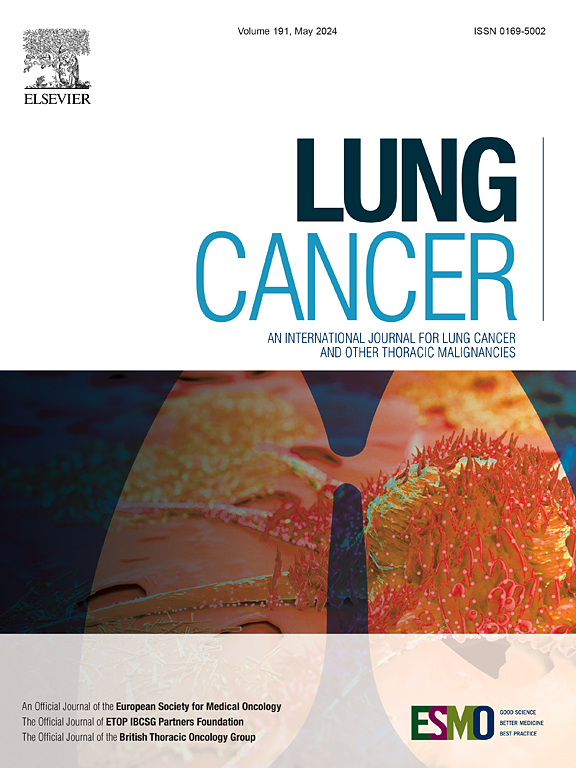A biomarker exploration in small-cell lung cancer for brain metastases risk and prophylactic cranial irradiation therapy efficacy
IF 4.5
2区 医学
Q1 ONCOLOGY
引用次数: 0
Abstract
Background
Small-cell lung cancer (SCLC) is an aggressive malignancy with a poor prognosis. Limited-stage (LS)-SCLC comprises only one-third of SCLC cases, resulting in limited molecularly targeted therapies and treatment options. Despite advances in thoracic and cranial irradiation leading to improved outcomes, a notable proportion of patients develop brain metastasis (BM), highlighting the importance of identifying high-risk patients for tailored screening and treatment strategies.
Materials and Methods
We analyzed baseline tumor biopsies from 180 LS-SCLC patients who received frontline definitive chemoradiotherapy (dCRT) using a 474-gene pan-cancer panel. The cumulative incidence of BM was calculated with death scored as a competing risk. Independent prognostic factors for BM risk were identified using the Fine-Gray model.
Results
Alterations in the cell cycle pathway, particularly RB1 mutations, were more common in patients with BM, while FLT4 mutations were more frequent in those without BM (P=0.002 and P=0.021, respectively). Significant risk factors for BM include smoking (subdistribution hazard ratio [SHR]: 1.73; 95 % confidence interval [CI]: 1.11–2.70; P=0.016), RB1 mutations (SHR: 2.19; 95 % CI: 1.27–3.81; P=0.005), and BCL3 amplification (SHR: 2.27; 95 % CI: 1.09–4.71; P=0.028). Conversely, prophylactic cranial irradiation (PCI) (SHR: 0.39; 95 % CI: 0.25–1.60; P<0.001), FLT4 mutations (SHR: 0.26; 95 % CI: 0.07–0.98; P=0.047), and NOTCH pathway alterations (SHR: 0.65; 95 % CI: 0.43–1.00; P=0.049) were associated with a lower incidence of BM in LS-SCLC. Notably, consolidation PCI therapy did not reduce the BM risk in patients with baseline RB1 mutations, with BM occurrence probabilities of 34.7 % at 20 months and 62.6 % at 40 months.
Conclusion
Our study yields valuable insights into the genetic characteristics of LS-SCLC patients with and without BM, aiding the development of personalized treatment strategies. Identifying risk factors associated with the incidence and timing of BM, within the standard regimen of dCRT followed by PCI, may help optimize clinical decision-making for LS-SCLC.
小细胞肺癌脑转移风险和预防性颅内照射疗效的生物标志物探索
背景小细胞肺癌(SCLC)是一种侵袭性恶性肿瘤,预后较差。局限期(LS)-SCLC 仅占 SCLC 病例的三分之一,因此分子靶向疗法和治疗方案有限。尽管胸腔和头颅照射治疗的进步改善了患者的预后,但仍有相当一部分患者发生了脑转移(BM),这凸显了识别高危患者以制定有针对性的筛查和治疗策略的重要性。材料与方法我们使用 474 个泛癌基因面板分析了 180 例接受前线确定性化放疗(dCRT)的 LS-SCLC 患者的基线肿瘤活检。我们计算了肿瘤坏死的累积发生率,并将死亡作为竞争风险进行评分。结果细胞周期通路中的畸变,尤其是RB1突变,在骨髓瘤患者中更为常见,而FLT4突变在无骨髓瘤患者中更为常见(分别为P=0.002和P=0.021)。BM的重要风险因素包括吸烟(亚分布危险比 [SHR]:1.73;95 % 置信区间:1.73;95 % 置信区间:1.73):1.73; 95 % 置信区间 [CI]:1.11-2.70;P=0.016)、RB1 突变(SHR:2.19;95 % CI:1.27-3.81;P=0.005)和 BCL3 扩增(SHR:2.27;95 % CI:1.09-4.71;P=0.028)。相反,预防性头颅照射(PCI)(SHR:0.39;95 % CI:0.25-1.60;P<0.001)、FLT4突变(SHR:0.26;95 % CI:0.07-0.98;P=0.047)和NOTCH通路改变(SHR:0.65;95 % CI:0.43-1.00;P=0.049)与LS-SCLC较低的BM发生率相关。值得注意的是,PCI巩固治疗并未降低基线RB1突变患者的BM风险,20个月时BM发生概率为34.7%,40个月时为62.6%。在先进行dCRT再进行PCI的标准治疗方案中,找出与BM发生率和发生时间相关的风险因素,有助于优化LS-SCLC的临床决策。
本文章由计算机程序翻译,如有差异,请以英文原文为准。
求助全文
约1分钟内获得全文
求助全文
来源期刊

Lung Cancer
医学-呼吸系统
CiteScore
9.40
自引率
3.80%
发文量
407
审稿时长
25 days
期刊介绍:
Lung Cancer is an international publication covering the clinical, translational and basic science of malignancies of the lung and chest region.Original research articles, early reports, review articles, editorials and correspondence covering the prevention, epidemiology and etiology, basic biology, pathology, clinical assessment, surgery, chemotherapy, radiotherapy, combined treatment modalities, other treatment modalities and outcomes of lung cancer are welcome.
 求助内容:
求助内容: 应助结果提醒方式:
应助结果提醒方式:


